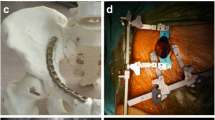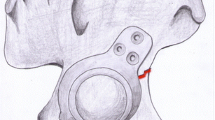Abstract
Purpose
The primary aim of this study was to compare clinical outcomes in patients with associated both column (ABC) acetabular fractures with fracture of the posterior wall (PW), in which the PW underwent reduction and fragment-specific fixation versus those that were treated with column fixation alone. Secondary aims were to assess PW fracture incidence and morphology, as well as to compare radiographic outcomes including fracture healing and interval displacement of the PW in those that did and did not undergo fragment-specific fixation of the PW.
Methods
This was a retrospective series of ABC acetabular fractures treated at a single Level I trauma center. Separate fractures of the PW were identified, and associated features were assessed. Associated both column fractures that underwent reduction and fragment-specific fixation of the PW where then compared to ABC fractures with PW involvement that underwent column reconstruction alone. Radiographic and clinical outcomes were compared.
Results
Fractures of the PW occurred in 55.7% of ABC fractures and were associated with central displacement of the femoral head. The majority of PW fractures were large and involved the acetabular roof. All PW fractures healed without displacement by 3 months, regardless of whether or not reduction and stabilization was performed. Mid-term outcomes at 1-year were similar regardless of whether or not the PW was reduced and stabilized, with regards to Tönnis grade, Merle d'Aubigné-Postel score, and conversion to total hip arthroplasty.
Conclusion
Reduction and fragment-specific fixation of the PW component of ABC acetabular fractures did not improve outcomes in this small comparative study. Posterior wall fractures associated with ABC patterns are frequently large-sized fragments that involve the acetabular roof and are rendered stable after reconstruction of the columns.





Similar content being viewed by others
References
Letournel E, Judet R (1993) Fractures of the acetabulum, 2nd edn. Springer, New York
Gänsslen A, Frink M, Hildebrand F, Krettek C (2012) Both column fractures of the acetabulum: epidemiology, operative management and long-term-results. Acta Chir Orthop Traumatol Cech 79(2):107–113
Wang H, Utku K, Zhuang Y, Zhang K, Fu YH, Wei X et al (2017) Post wall fixation by lag screw only in associated both column fractures with posterior wall involvement. Injury 48(7):1510–1517
Min BW, Lee KJ, Jung JW, Kim GW, Song KS, Bae KC et al (2018) Outcomes are equivalent for two-column acetabular fractures either with or without posterior-wall fractures. Arch Orthop Trauma Surg 138(9):1223–1234
Tian S, Chen Y, Yin Y, Zhang R, Hou Z, Zhang Y (2019) Morphological characteristics of posterior wall fragments associated with acetabular both-column fracture. Sci Rep 9(1):20164
Shin KH, Choi JH, Han SB (2020) Posterior wall fractures associated with both-column acetabular fractures can be skilfully ignored. Orthop Traumatol Surg Res 106(5):885–892
Tannast M, Najibi S, Matta JM (2012) Two to twenty-year survivorship of the hip in 810 patients with operatively treated acetabular fractures. J Bone Joint Surg Am 94(17):1559–1567
Keith JE, Brashear HR, Guilford WB (1988) Stability of posterior fracture-dislocations of the hip. Quantitative assessment using computed tomography. J Bone Joint Surg Am. 70(5):711–714
Matta JM (1996) Fractures of the acetabulum: accuracy of reduction and clinical results in patients managed operatively within three weeks after the injury. J Bone Joint Surg Am 78(11):1632–1645
Ficat P, Arlet J, (1980) Necrosis of the Femoral Head. Ischemia and necrosis of bone. Williams & Wilkins, Baltimore , pp 53–74
Moed BR, Smith ST (1996) Three-view radiographic assessment of heterotopic ossification after acetabular fracture surgery. J Orthop Trauma 10(2):93–98
Tönnis D, Heinecke A (1999) Acetabular and femoral anteversion: relationship with osteoarthritis of the hip. J Bone Joint Surg Am 81(12):1747–1770
Bosse MJ, Poka A, Reinert CM, Ellwanger F, Slawson R, McDevitt ER (1988) Heterotopic ossification as a complication of acetabular fracture. Prophylaxis with low-dose irradiation. J Bone Joint Surg Am. 70(8):1231–1237
D’Aubigne RM, Postel M (1954) Functional results of hip arthroplasty with acrylic prosthesis. J Bone Joint Surg Am 36-A(3):451–475
Gorczyca JT, Powell JN, Tile M (1995) Lateral extension of the ilioinguinal incision in the operative treatment of acetabulum fractures. Injury 26(3):207–212
Bhandari M, Matta J, Ferguson T, Matthys G (2006) Predictors of clinical and radiological outcome in patients with fractures of the acetabulum and concomitant posterior dislocation of the hip. J Bone Joint Surg Br 88(12):1618–1624
Moed BR, Carr SE, Gruson KI, Watson JT, Craig JG (2003) Computed tomographic assessment of fractures of the posterior wall of the acetabulum after operative treatment. J Bone Joint Surg Am 85(3):512–522
Moed BR, McMichael JC (2007) Outcomes of posterior wall fractures of the acetabulum. J Bone Joint Surg Am 89(6):1170–1176
Tosounidis TH, Giannoudis PV (2017) Use of inlet-obturator oblique view (leeds view) for placement of posterior wall screws in acetabular fracture surgery. J Orthop Trauma 31(4):e133–e136
Author information
Authors and Affiliations
Corresponding author
Ethics declarations
Conflict of interest
M.J.G. receives personal fees from Pacira Pharmaceuticals, Biocomposites, BoneSupport AB, Conventus, Globus Medical, StabilizOrtho, Synthes, and from KCI outside of the submitted work. J.A.B. receives personal fees from Globus Medical and Innomed outside of the submitted work. None of the remaining authors has anything to disclose.
Ethical approval
This article contained only de-identified human participant information and was approved by an institutional review board.
Additional information
Publisher's Note
Springer Nature remains neutral with regard to jurisdictional claims in published maps and institutional affiliations.
Rights and permissions
About this article
Cite this article
Chen, M.J., Hollyer, I., Wadhwa, H. et al. Management of the posterior wall fracture in associated both column fractures of the acetabulum. Eur J Orthop Surg Traumatol 31, 1047–1054 (2021). https://doi.org/10.1007/s00590-020-02850-9
Received:
Accepted:
Published:
Issue Date:
DOI: https://doi.org/10.1007/s00590-020-02850-9




